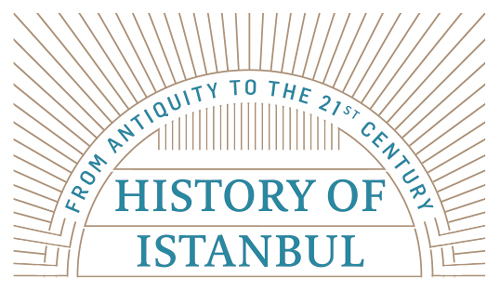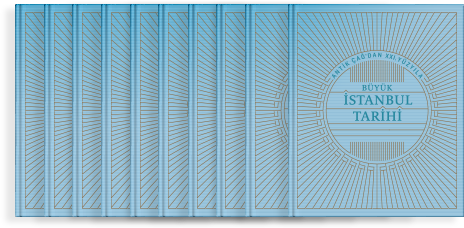In every era, transportation has been of great significance for societies; transportation has an important role not only in economic, but also in social and cultural developments. At different periods of time transportation has taken place on seas, rivers and lakes, or on land. Thanks to its unique topography, Istanbul, one of the world’s leading cities, has been a lively and colorful hub throughout every period of history for both land and maritime trade and transport. The examination of the relationship between Istanbul and the sea over a large span of time reflects the history of the city, as both the city and the sea underwent various changes and transformations. Maritime travel was a convenient, rapid and indispensable way of transportation compared to the relatively insecure and troublesome land roads of the time. The Ottoman State used the seas for trade and passenger transport, as well as for military expeditions. Before the nineteenth century, instead of arranging separate trips for the passengers, the widespread practice was to carry passengers on the same vessel as commercial goods. However, when the distances were not far, only passengers boarded the ships. Prior to the invention of steamships maritime transport depended on schooners equipped with oars. Major port cities were located on center points of important shipping lanes; one of the most important centers was Istanbul, which was the destination and departure point for journeys from distant and nearby locations.
Due to its location Istanbul was a key center not only for maritime transport, but also for land transport. However, in this city surrounded by the sea, maritime transport occupied first place in terms of trade volume. The reason for this was that the city, which had a high population density, did not have the production capacity to meet its own demands. Therefore, the use of maritime trade was essential in order to feed the city, and, even more significantly, Istanbul offered sheltered harbors, such as the Golden Horn, where even large-tonnage vessels could easily set sail and port comfortably. When the Bosphorus was closed due to inclement weather or enemy sieges, the cost of living would rise and life would become difficult for Istanbul residents. In fact, the construction of the Rumeli Castle before the conquest of Constantinople prevented the shipment of grain to the city.1
Although there were derbent (road safety) and menzil (accommodation) organizations, the relatively low number of roads, adverse road conditions and slow transportation made the seaway preferable for voyages. In addition to using the available land routes, pilgrims demanded ships that traveled to the ports of Alexandria and Jeddah. If one were to delineate an outline of Istanbul-based maritime traffic, it would consist of traffic between Istanbul and Mediterranean ports, Istanbul and African ports and Istanbul and Black Sea ports. The Istanbul-Black Sea ports lane was particularly busy, with a large number of permanent routes for ships that carried freight and passengers. Foreign vessels were used for lengthy voyages, because Ottoman vessels typically were small; these larger foreign ships occupied a greater part of the market in the eighteenth century. In the 1780s 150 French ships carried out transport between the Eastern Mediterranean and Africa until the Anglo-French war broke out, causing them to be overtaken by the Greeks. The influence of foreigners increased in the transport sector in the nineteenth century, as in other areas of the Ottoman economy. Despite various measures taken by the government, it was not possible to control the involvement of foreigners, particularly in the field of maritime transport for commercial purposes.
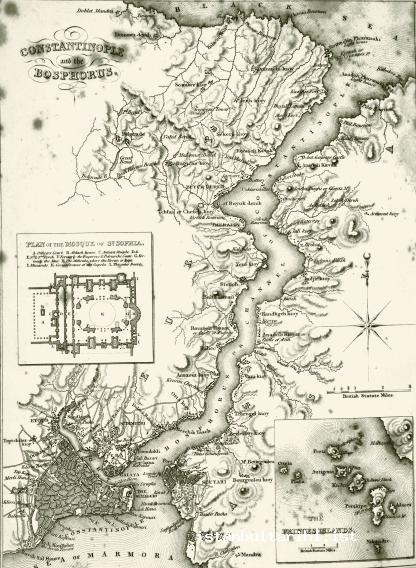
When examining the history of Istanbul’s harbors and ports the city’s geography is one of the major factors that caused it to lead in maritime transport. Istanbul’s convenient port was formed during the third geological era and came into existence after the descent of the Thracian and Bithynian crust in the upper level of the fourth geological era. It can be seen that throughout history the coastlines of Istanbul have gradually approached one another as more and more debris filled in the space. However, Istanbul’s coasts, which allow large ships that carry freight and/or passengers, still have substantial depth and length; the importance of this should not be underestimated. The Bosphorus, although intersecting the land route between Europe and Asia, allows safe and easy passage via its harbors; thus Istanbul has been a vibrant commercial hub since the period of Greek colonization in the seventh century B.C.2 It is known that Byzantion, established by Megaras between 660-658 B.C., had three major ports, and income was generated by moving grain from these points and thanks to the transitions along the Bosphorus. At the beginning of the fourth century B.C., the Prosforion Port, located in what is currently Eminönü, was home to warehouses where grain and necessary supplies were stored. Directly next to this harbor was Neorion Port, where shipbuilders and craftsmen carried out repairs; there was also a port at Balatkapı. Between 361 and 363 A.D., the construction of Iulianus port, later to be called Kontoskalion, was begun to the south of the city. It is thought that this port carried out some of the trade in Neorion and that naval services were later shifted there. On the south side of Byzantion, where Kontoskalion Port was located, were also the Boukoleon and Theodosius ports. An important port was established in Beşiktaş in 469 A.D. and shipyards were constructed in the Golden Horn, probably in the place where the shipyard is currently located.3 In contrast to the city’s lively image, before the conquest of Constantinople there were not many residential areas outside the city walls. As for the Bosphorus, there were a few settlements, the inhabitants of which relied on fishing.4 After the conquest, many residential neighborhoods developed in areas, which had been uninhabited under the Byzantine rule. Turkish neighborhoods were established on the Galata side, which had been a built-up and populated area for quite some time. In addition, the city spread in other directions, such as along the Tophane, Fındıklı and Rumeli coastal regions, where residential areas and new settlements were established. How rapidly construction activities took off after the conquest can be seen from the appointment of Molla Hüsrev as the judge of Istanbul, Eyüp, Galata and Üsküdar in 1459.5
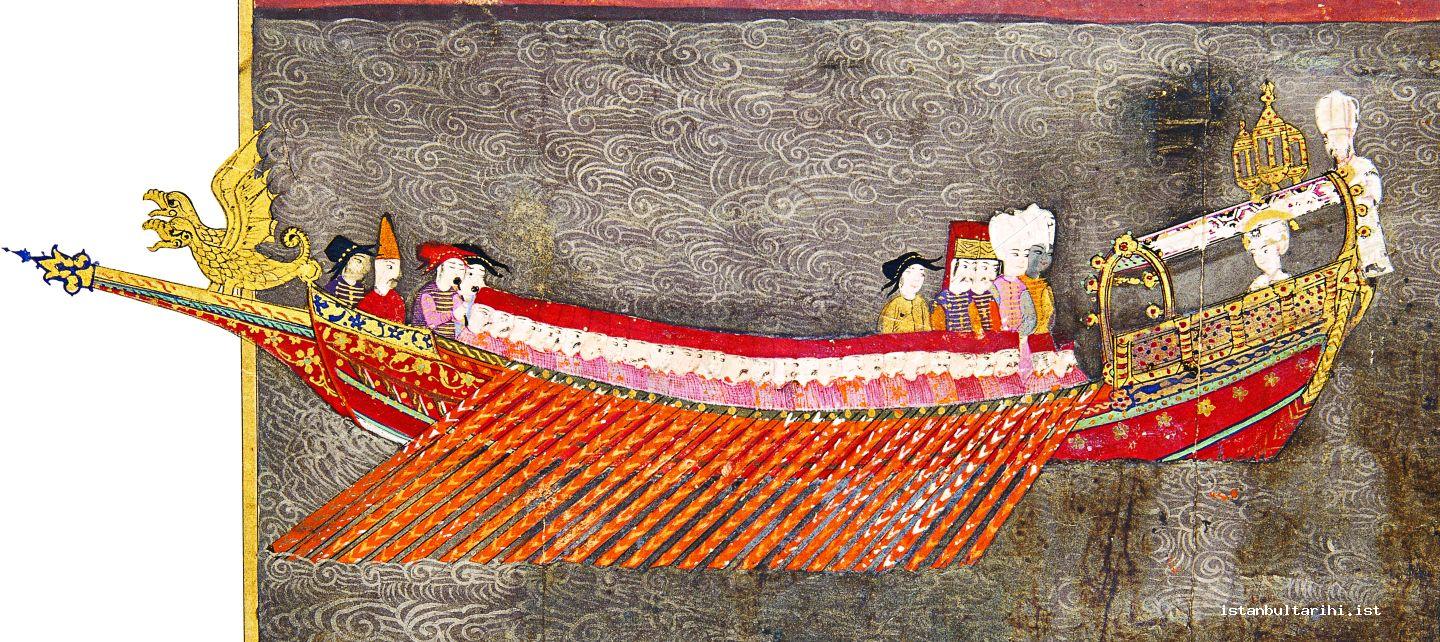
Thus, starting from the end of the fifteenth century, Istanbul’s residential areas comprised of the part within the city walls, which was called “Istanbul” as well as of the villages in Galata, the Golden Horn, Üsküdar, Kadıköy and the Bosphorus region. The most frequently utilized lines of transportation were, naturally, the ports close to the palace, those that were near to the regions and those with a dense trade volume. These included the areas from Bahçekapı to Unkapanı and Galata. The natural conditions of Istanbul’s harbors, which provided water that was deep enough for ships to berth in, and which made it easy for them to load and unload their cargo, were basic factors providing the city with high volume of trade. In fact, foreign travelers gave very positive reports about these harbors. In the sixteenth and seventeenth centuries the coastline from Bahçekapı to Unkapanı was overflowing with ships travelling from the Princess Islands, the Mediterranean and İzmit;6 customs duties were collected in Gümrükhane.7 A large number of boats bustled between the busiest and liveliest ports of Istanbul.
The main port, Bahçekapı, was the home for ships that sailed in the Golden Horn and the Bosphorus. In the seventeenth century, the Bahçekapı ports were organized according to destination. Meydan Port served ships and boats that transported wood to the palace. Further along the coast was the port for boats that traveled to the Üsküdar and Bursa coasts, and a little further still, the port for boats going to the regions between Galata and Tophane. Three ports were located in the Balıkpazarı (Fish Market); one of these boats departed to the Anatolian side while boats left for the villages from the other two. These were then followed by the other ports, which were for boats going to Hasköy and Balat; further on were the ports for boats traveling to destinations in Mihaliç, Bandırma and İzmir.8 It is said that the largest port in this century was Tophane.9 The British traveler Moryson, who visited Turkey in 1595, stated that Tophane Port was the most critical water transit.10 During the eighteenth and nineteenth centuries, the situation continued in very much the same way. Although there was an inn, a market and a bazaar in Istanbul, the reflection of the residents of Galata making the bulk of their purchases in the city11 and Üsküdar residents going there frequently tells us that there was constant traffic in the harbor and that ships were coming and going from the Bahçekapı ports. The majority of Arnavutköy and Kuruçeşme inhabitants commuted to Istanbul for work, and they even asked for permission to construct a market boat in 1760, thus demonstrating the necessity of transport between the center of Istanbul and areas in the vicinity.12
Naturally, the most active areas of the city were those located along access routes. One of these points, the area of Galata, was where many Genoese resided before the conquest, and a location in which there was busy maritime trade.13 In the sixteenth century, the situation was the same and the easiest means of transport was still the peremes14 (gondola-like boats). This area was also a diplomatic center, which had been occupied by different nations since the time of Sultan Süleyman I.15 Another reason for the hustle and bustle of Galata was that the pubs and the shipyard had always been located here.16 More specifically, after the conquest of Constantinople, Kadırga Port was used as a harbor for a while, and then the first Galata shipyard was built in the Aynalıkavak district of the Golden Horn. Although initially only consisting of a few rooms, during the reign of Yavuz Sultan Selim this shipyard was re-designed to include 300 rooms. In the sixteenth century, we can see that extensions of the shipyard spread from Azapkapı to Hasköy.17 An inevitable consequence of the prime geographical and physical location was that a great deal of commercial activity took place in these areas of Galata. It can be understood from the engravings and paintings of this period that the most crowded and largest ports in Istanbul were Tophane and Bahçekapı, particularly the Tophane and Golden Horn harbor entrances.18
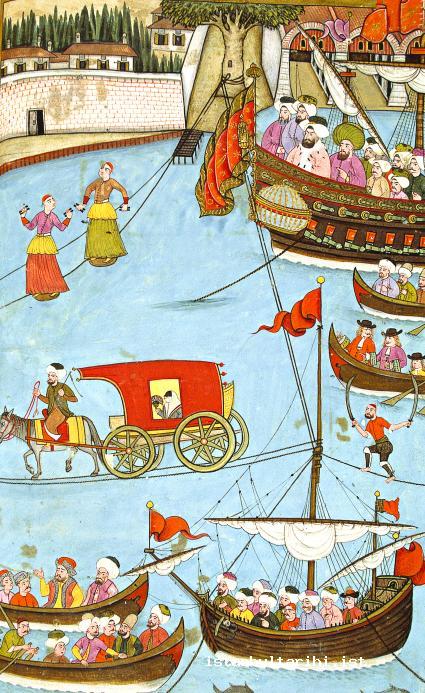
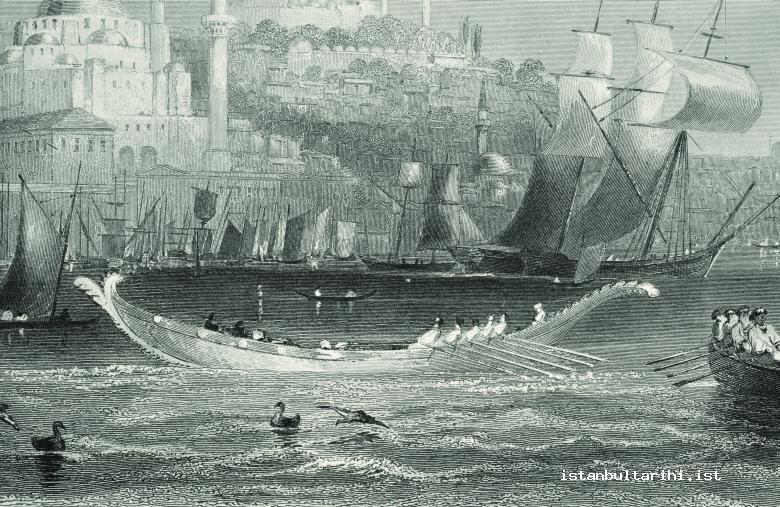
The Eyüp district had a particular social importance due to the fact that the Mausoleum of Eyüp Sultan is located in this region. People would travel on market boats from the furthest districts of Istanbul, even from Üsküdar and the Bosphorus, in order to perform their Friday prayers there. High-ranking bureaucrats gave a special importance to visit the mausoleum from time to time and made special vows or sacrificed a ram.19 For centuries, the garden of the mausoleum was one of the meeting places for Ottoman women. The Eyüp Gardens were a location favored by women when they were out shopping; the typical means of transport was boat.20
Despite there being bridges in Istanbul, maritime traffic was particularly intense at the entrance to the Golden Horn, even at the end of the nineteenth century.21 Military installations and barracks, typically placed near the ports, were a further source of activity. Additionally, every district of the city had different characteristics, which influenced the demands made on the ports. Some of the ports were close to excursion spots. Although from the sixteenth century on boats were rented in relation to these excursion destinations, the main transport needs of Istanbul were concerned with official and unofficial demands and the distribution of goods across the region. For commercial purposes, for religious activities, or even walking excursions, the boat was an indispensable means of transport for Istanbul residents in these eras. On the other hand, there were complaints that the new peremes, which were so easily capsized that many people could not even board them.
Ports
Throughout the history of Istanbul, the key points of maritime traffic for domestic ports were the Eminönü-Üsküdar, Eminönü-Galata (Karaköy) and Eminönü-Mudanya lines. The Gallipoli and İzmit routes were more distant, but they could still be reached by boat.22 Through the mid-eighteenth century, Eyüp, Defterdar, Fener, Hasköy, Aynalıkavak, Kasımpaşa, Azapkapı, Balıkpazarı, Karaköy, Tophane, Beşiktaş, Yenikapı, Cibalikapısı, Kapanıdakik, Bahçekapı, Ahırkapı, Çatladıkapı, Kumkapı, Yenikapı (Langa), Samatya, Üsküdar and Kadıköy were the main ports.23 The transport routes between these ports were used heavily from the sixteenth century until recently. In addition to market boats, there were other vessels, which would travel to destinations along the Bosphorus; however, these boats were expensive and the ports on both sides of the Bosphorus were dangerous. These ports included Ortaköy on the Rumeli side, and İstavroz, Beylerbeyi and Kavaklar on the Anatolian side. The sparse population in the settlements in these areas was one of the reasons why these ports were not very safe.
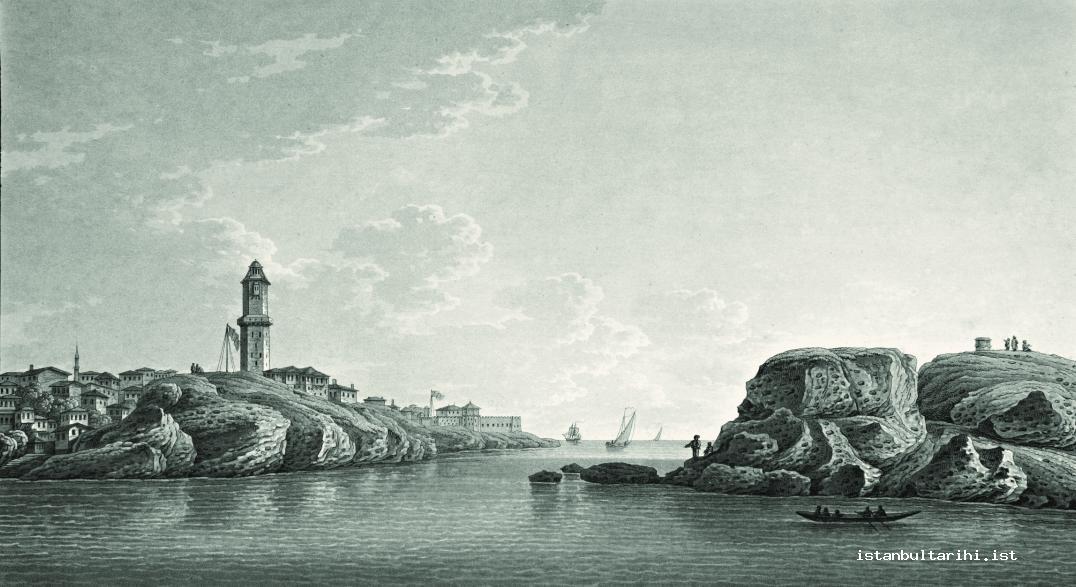

In a register of Bostancı, dated to 1815, all of the Istanbul ports are given. The main ports are designated in italics in the list:24
Istanbul Agha Port, Bursa and Mudanya Boat Port, Ortaköy and Beşiktaş ports, Balıkpazarı and Tophane ports, Karaköy Port, Hasköy Port, Duhan Customs Front Port, Hasır Port, Çardak Port, Yemiş Port, Tulumba Port, Ayazmakapı Port, Tekfurdağı Port, Kapanıdakik Port, Balıkhane Port, Tüfenkhane Port, Cibali Port, Ayakapı Port, Bab-ı cedid Port, Aralık Port, Fener Port, Balat port, Hasköy Port, Taşçılar Port, Arslan Port, Ayvansaray Port, Çamur Port, Defterdar Port, Balçık port, Eyup Ansari Port, Yalı Hamamı Port, Sütlüce Port, Humbaracıyan Barracks and Port, Halıcıoğlu Port, Buzhane Port, Piri Pasha Port, Hamam Port, Salhane Port Aralık Port, Office of Tersane Kethuda and Port, Kasimpasa Port, Meyyit Port, Azapkapı Port, Funda Port, Kürkçükapı Port, Atik Yağkapanı Port, Galata Fishmarket Port, Karaköykapısı Port, Kurşunlumahzen Port, Mumhane Port, Eğrikapı Port, Kireçkapısı Port, Debbağhane Port, Sirkeci Port, Port Tophane, Tophane Kebir Port, Çavuşbaşı Port, Aralık Port, Yusufağa Masjid Port, Aralık Port, Port Salıpazarı December Port, Hamallar Port, Fındıklı Port, Aralık Port, Karaabalı Port, Dolmabahce Port, Port Hayrettin Pasha Mosque, Madrasa and Port, Besiktas Port, Haraççııbaşı Port, Aralık Port, Kılıçalipaşa Port, Yahyaefendi Creek and Port, Aralık Port, Ortaköy Port, Koyun Port, Kuruçeşme Port, Aralık Port, Kuyumcubaşı Port, Arnavutkaryesi Port, Aralık Port, Sultan Ahmet III Mosque, Fountain and Port, Rumeli Hisar Mosque Fronted-Port, Hisar Port, Bath & Port, Mekkizade Fountain and Port, Çerkezbeyzade Rahmi Bey Boatyards, Baltalimanı Lumber Fronted-Port, Mirgunoğlu Port, İstinye Marketplace Port , Yeniköy Market Boat Port, the Market Port, Ekmekçi Port, Yeniköy Port, The Other Ekmekçi Port, Aralık Port, Port and the Lumber Square, Aralık Port, Simitçi Port, Aralık Port, Köybaşı Port, Tarabya Masjid Bridgehead Port, Yukarımahalle Port, Sarıyer Hamam Port, Market Boat Port, Sarıyer Port, Rumelikavağı Port, Anadolukavağı Port, Market and Café Port, Hünkar Port, Yalı Karyesi Port, Beykoz Court and Kireç Kayışı Port, Beykoz Port, İncirkaryesi Port, Çakalburnu Aralık Port, Vakıf Aralık Port, Salhane-i Ganem and its Port, Kanlıca Port and Market Boat Port, Aralık Port, Other Aralık Port, Bahariye Bay and Port, Çınarlı Fountain and Port, Hamam Port, Port Kefeli, Kandilli Port, Çengelkaryesi Port, Havuz Port, port around Sultan Abdülhamit Mosque, Aralık Port, Kuzguncuk Port, Port of Okuz, Üsküdar Grand Port, Port Balaban, Ayazma Port, Salacak Port, Haydarpasa Port.
According to the information in this register, there were thirty-three ports between Istanbul Agha Port and Eyüp Port, while between Sütlüce Port and Tophane Port there were twenty-four ports and between Tophane and Rumeli Kavağı there were fifty-six ports. Between Anadolu Kavağı and Haydarpaşa Port there were twenty-six ports. Furthermore, we can see that about 148 large and small ports existed in Istanbul in 1815, if the main ports of Ahırkapı, Çatladıkapı, Kumkapı Yenikapı, Davutpaşa and Samatya on the Marmara side are added to the 142 ports in the list above.
During the Ottoman period, the locations of some ports were obliterated by water coming inland. For example, at the end of the seventeenth century in Balat, in addition to the large port where ships loaded with wood, coal, onions and other goods docked, there were three small ports. From the port opposite to Aynalıkavak Palace, piyade boats departed for Yemiş Port and Galata, and boats left for Hasköy, Eyüp, Kağıthane and Alibeyköy from the other two ports at the same location.25 There was a small peninsula in front of Balat in 1838 and on one side of the peninsula was a dock that could be entered through a narrow strait. One of the ports located here belonged to the çifte (oar) boats which operated to all of the ports to the east of the Golden Horn and the boats with two, three, and four pairs of oars which went to Kadıköy, Üsküdar and up the Bosphorus. The other port belonged to Hasköy-bound çifte boats, with one more belonging to the çifte boats that went to Halıcıoğlu.26 A ferry port was built in 1918 on the cape that was formed with landfill in this area, and there was a port in the cove on the eastside of the cape.27
Lighthouses
Lighthouses were crucial for safe navigation as well as for the secure docking of boats in the ports. The sea currents and winds of Istanbul could be hazardous, and the Bosphorus entrance to the Black Sea was particularly dangerous for vessels. It is known that since ancient times, lighthouses have been used in order to lessen these dangers and to prevent maritime accidents.28 For example, in addition to the lighthouse in Fenerbahçe, which had been used during the Byzantine era, remaining idle afterwards, there are reports about the construction of a large lighthouse.29 In the sixteenth century, there were lighthouses on the south side of the city overlooking the Marmara Sea and at the point where the Black Sea meets with the Bosphorus.30 In particular, from the end of the eighteenth century onward, one of the safety measures undertaken for maritime transportation was the lighting of a lamp in dangerous conditions. The lighthouses located in the Maiden’s Tower and Çatladıkapı were of this kind. Olive oil was used for the oil lamps. Moreover, a variety of symbols or signs were placed on the sea, and occasional maintenance was carried out.31 In 1855, due to the initiatives of Mişel Pasha, the Memalik-i Mahruse Fenerler İdaresi (Lighthouse Administration of Well-Protected Domains) was formed, and the following year the Rumeli, Anatolia, and Yeşilköy lighthouses were modernized. In 1857, the Ahırkapı Lighthouse and other lighthouses were constructed along the Çanakkale-Istanbul sea route and their number increased over time. Maritime companies were charged a fee for lighthouse services. In addition to lighthouses, sea rescue services were introduced, and buoys were placed on the water in the post-Tanzimat period in order to increase water safety.32
Boats
As far as passenger transportation is concerned, throughout the classical era, the sole form of maritime transportation in Istanbul was the kayık (boat), which were called by a variety of names. Two factors stand out in this respect: the speed of the boats and travel safety. Most of the time, however, the balance was in favor of speed. Thus, it could be said that speed was the determining factor in the design of the boats. During the classical era boat speed and the boatmen’s abilities to transport the passengers to destinations as quickly as possible were certainly crucial factors which led to the preference for sea travel over the poor land routes that were available at the time. Indeed, the speed of the boats is mentioned in many surviving accounts. For example, in order to test the convenience of the boats, in the seventeenth century a traveler named Thevenot walked from Sarayburnu to Yedikule on foot; it took him one hour and forty-five minutes. Leaving Yedikule in a boat rowed by three people, it took him an hour to return to his starting point.33 Thevenot states that it took three or four hours to reach the end of the Bosporus.34 Many foreigners living in Turkey at the end of the nineteenth century mentioned that the boats were a quick means of transportation. According to such sources, in 1843 it took ten minutes to go from Galata to Balıkpazarı,35 and an hour and a half to go from Büyükdere to Pera36 if one were in a boat traveling downriver. Adolphus Slade specifies that the easiest way to travel to Tarabya in the summer months was by boat, but in winter it was by horse.37

At the end of the eighteenth century, the villages along the Bosporus were almost inaccessible by land route or carriage. On the other hand, Istanbul residents were using boats not only for business but also for pleasure, and they took great joy in sea travel. Dignitaries almost never travelled by carriage, preferring to ride in boats.38 Robert Walsh agreed with the other travelers about the advantages of the boat and the prevalence of its use. His illustrative description of the period is as follows:
Their only carriages are arrhubas, which are clumsy wagons drawn by buffaloes or oxen, the coarser kind used for carrying merchandise, and those of a somewhat better construction for conveying women from place to place. Under the best circumstances, their motion without springs would be very uneasy; but on the disjointed stones called pavement in the city and the rugged paths called roads in the country it is quite intolerable…. But the Bosphorus presents a man with a mode of conveyance exactly suited to his habits and feelings; the caiques are so constructed that they afford him not only a seat, but a couch. A carpet is laid on the bottom, and a cushion at the stern; on these he stretches himself at full length, with his shoulders and elbows supported, and his chibouk extended out between his legs … It is impossible to conceive a more perfect picture of indolent repose than a large Turk, with his turban, robe, loose trousers and slippers, reclined in a light skiff, which he seems to fill like a fish its shell, gliding along the tranquil surface of the glassy current. It is for this facility of conveyance that the shores of the Bosphorus are so thickly inhabited, and the water is covered with the only mode of conveyance a Turk wishes to avail himself of.39
Some of the goods which were to be transported to Istanbul were loaded onto rafts on the Danube and Maritsa rivers and brought to İnoz; from there they were transported to Istanbul.40 In addition to transporting passengers and goods, boats would carry fire pumps during fires, and were used for the transportation of troops and munitions when necessary. Boats were symbols of social status, the most dignified means of travel to meetings and house parties, day trips to the countryside, excursions or weddings. Being at the core of life, boats were classified according to their passengers, such as the “ambassador’s caique.” The private boat of the sultan, the sultan’s caique, was the most exceptional of these private vessels. Ambassadors’ boats were exclusively used by the ambassadors from various countries in Istanbul. The boats of the Ottoman statesmen and the officials were generally specified by the number of çifte (sets of oars); they would be referred to as “the boat reserved for the grand vizier” or “the boat reserved for the şeyhülislam (chief jurist)” not as the “grand vizier’s boat, or the “şeyhülislam’s boat”.
Boats were classified according to their shapes, such as kancabaş (grapnel) or the number of pairs of oars, such as three pairs or five pairs. The word oturak was also used interchangeably with the word çifte for number of oars. Boats were additionally classified according to their function. The fireboat was used for fires, and market boats transported small-scale goods along with passengers from the Bosphorus to Istanbul; there were also dalyan (crawl) boats and ağ (net) boats, etc. It is also possible to classify boats based on the load they carried, such as wood boats, coal boats, lime boats, garbage boats, liquor boats or ice boats. Peremes and piyades were also used for the transport of wood, coal and commercial goods as well as for passenger transport.
The simplest way to classify boats is to divide them into three groups: public, private and commercial. Throughout Ottoman history, boats that were used for passenger transportation can be classified as peremes, piyades, horse boats, market boats, dolmacı boats, fire boats, small and large types of piyades and yağlı boats. Additionally, barges could carry passengers if necessary. Known as the oldest type of boat used during the Ottoman Period, peremes (gondola-like boats) were not very safe; their structural weakness caused them to be easily capsized if loaded unevenly. In 1640, peremes apparently consisted of two types, yılandili (snake-tongue) and kaba (rough). Both kinds had either four or six set of oars.
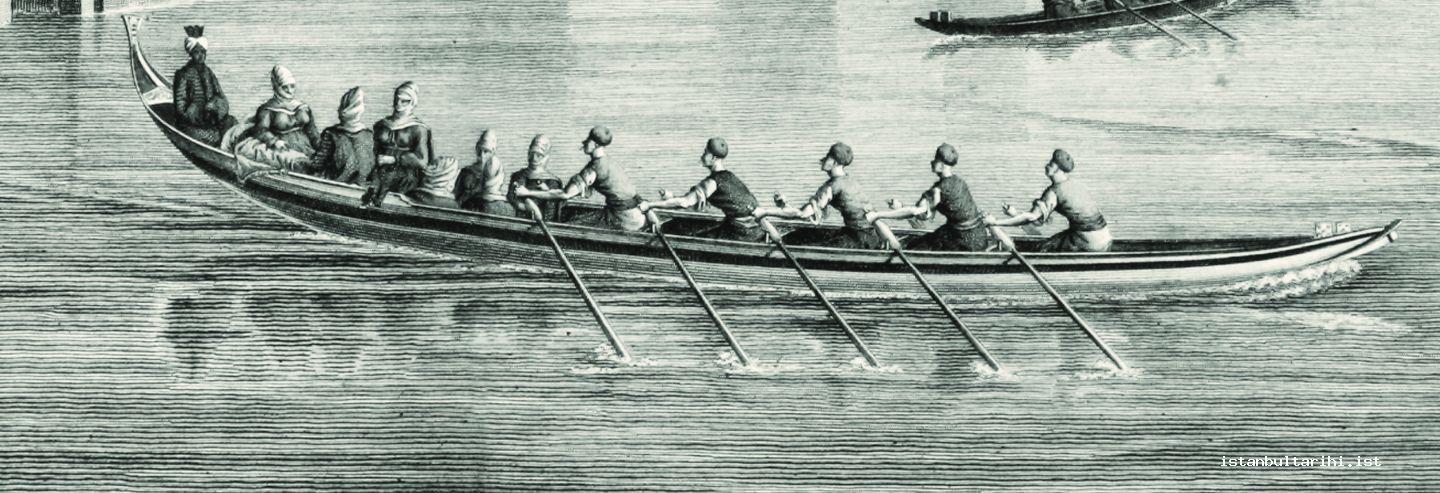

We know that from the end of the sixteenth century peremes began to be constructed differently, that is, long, narrow and with sails. This design made them prone to accidents. Peremes continued to be used until the end of the seventeenth century. In the imperial decree, dated to 1696, concerning the gathering of oarsmen, boatmen guilds were classified as kayıkçı, peremeci or mavnacı guilds. The word piyade, which refers to boats with oars, is found earliest in 1681. At that date, boats were often designated as piyade and then further classified as having two, three, or five pairs of oars. Those with two oars were the cheapest means of transport. In the eighteenth century, piyades were much sought after, and they remained popular until the end of the century, when they slowly disappeared due to the increasing number of sandals (skiff). In regulations dating from 1910 we can find the statement “boats known as piyade are cargo ships,” thus illustrating how this nineteenth-century icon of glory, the piyade boats, lost its status and became a mere cargo carriers.
In the sources, it is mentioned that with their thin, long and slender structure, piyades could easily capsize. Inexperienced people had difficulty when getting on these boats and they were told that during the journey nobody could shift their weight. By the end of the eighteenth century, sails had been added to these passenger boats, but these sails only caused the boats to capsize even more easily. As a result, there were many accidents and many people drowned. Through the middle of the nineteenth century sails were only used in good weather. During this period ballast was not put into some boats that were light and thin, and as a result, they could easily capsize in strong winds. The piyades’ narrow design helped the boat to cut through the water quickly, but also caused it to keel over easily. Although the banning of sails was mentioned in regulations issued in 1910, this ban did not have much effect on the boatmen, and sailors were hesitant to use sails. In the final Ottoman era, private piyades were referred to as yalı (mansion) piyades and public ones were called iskele (port) piyades.
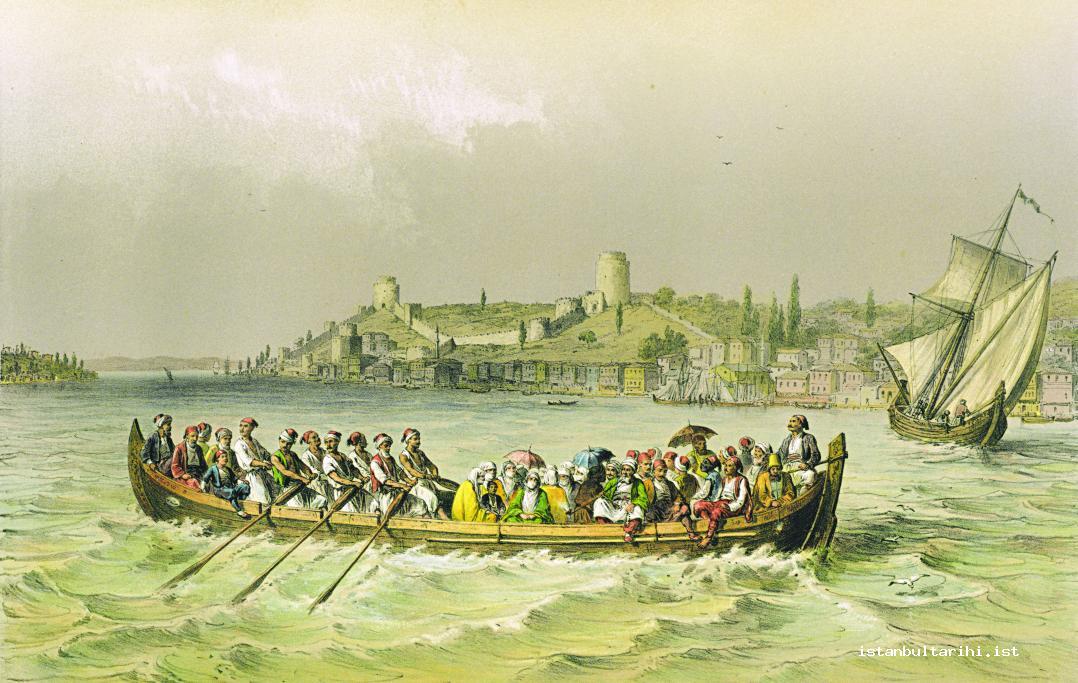
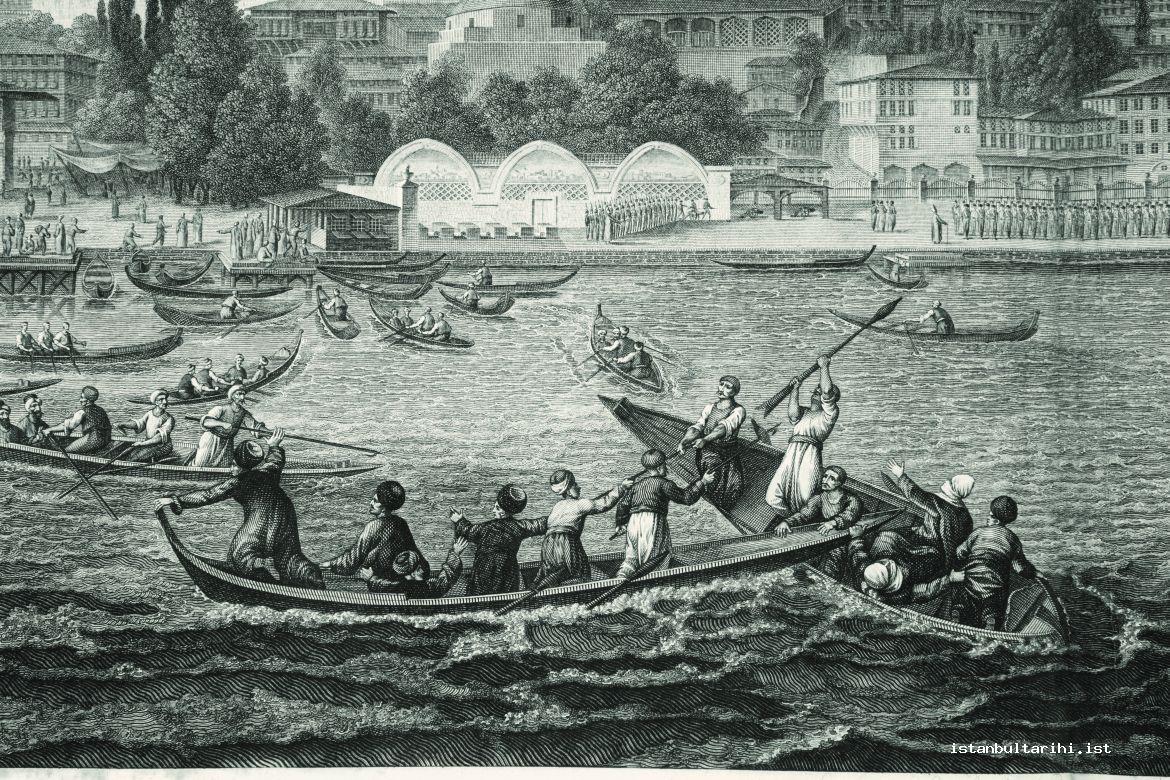
Barges were generally used for shipping freight. In the seventeenth century, the vessels that brought vinegar and lemon juice and those that transported horses were referred to as mavna (barges), and they were further specified depending on the load, such as brick mavna. Due to their size and cumbersome design, market boats fell into the mavna category, although they were not actually called mavna. There were many loaded barges in several Istanbul ports. For example, in the eighteenth century, bargemen and their separate steward (müstakil kethüda) worked at Ayazma and Unkapanı, as well as Galata Old Yağkapanı and the Üsküdar Horse Ports. Forty orta kayık in Odunkapı Çöplük Port also belonged to the barge group.
In the nineteenth century, in addition to the private and public passenger boats, there were larger and more unwieldy boats, which could have been classified as types of barges. Some of these had four pairs of oars and traveled to the islands in the Marmara Sea or to Bosphorus villages. If they had five or six pairs of oars, then the boats were referred to as mavna and were used as ferries between Üsküdar and the city. Because they were large and awkward, market boats were included into this group; they transported passengers and goods between the Golden Horn and Bosphorus villages from the era of Süleyman the Magnificent. The women would sit in the middle and the men would be in a separate area at the stern of the boat. Market boats were often rented for wedding ceremonies and bedecked with flowers, flags and handkerchiefs; they carried the bride along with her entourage. Most of the market boats, which were of different shapes, charged different fees, and were slower than other types of boats; these market boats were owned by waqfs (endowments). Indeed, during the reign of Süleyman the Magnificent, the former governor-general (beylerbeyi) of Egypt, İskender Pasha, donated a market pereme to a mosque he had built in Kanlıca.41 The ports at which these boats docked might have been owned by waqfs as well.
The boats used for public purposes in the nineteenth century can be divided up as follows: four-çifte single-oared dolmuş (shared-taxi) boats which transported passengers between Kadıköy and Istanbul, double-oared market boats transporting passengers and freight between Bosphorus villages and Istanbul, four single-oared crossing boats that came to the ports to take passengers to Istanbul after the departure of the market boats, fire boats used for passengers and to help fight fires, and wide, sturdy and thick barges with two pairs of oars to carry freight such as food, wood, animals and carriages. There were also Arap mavna, at mavna (horse barges), salapurya (lighters), içi teneke (tin-lined barges) and kaplı cephane mavna (ammunition barges), balık kayık (fishing boat), ağ kayık (net boat) and çırnık kayık boats, and Şile sailboats that carried mostly wood, coal and onions. Finally, there were wide ada yavrusu boats which could use sails if necessary; they transported passengers to the Bosphorus, Büyükada and Heybeliada islands, as well as taking people from the Prince’s Islands to Istanbul.
The Boatmen’s Guild
Because maritime transportation was always in great demand in the Ottoman period, the boatmen’s guild constituted a privileged group within Istanbul society. In terms of their power and responsibilities, boatmen organized themselves according to a hierarchy. The levels consisted of başkethüda (head steward), port kethüdas, kethüda representatives, bölükbaş (section chief), the masters or elders, boatmen and then şakirts (apprentices). This hierarchical scheme was the same as that in other guilds. However, the order of ranks in the boatmen’s guild was unique in that usually there were no yiğitbaşı, and the elder members of the guild would be listed after the kethüda in the majority of sources. Furthermore, as more boatmen in this guild came from the military than any other professional guild, bölükbaşıs were often found in their ranking system. Another difference was that in other guilds there were rankings of kethüdas, yiğitbaşıs, masters or elders, and şakirts. One of the particularly noticeable distinctions between the other guilds and the boatmen’s guild was that the number of kethüdas was proportional to the number of ports. Indeed, as the workplaces of other guilds were in specific locations of the city and they were not able to practice their profession at other locations,42 the number of kethüdas was limited.
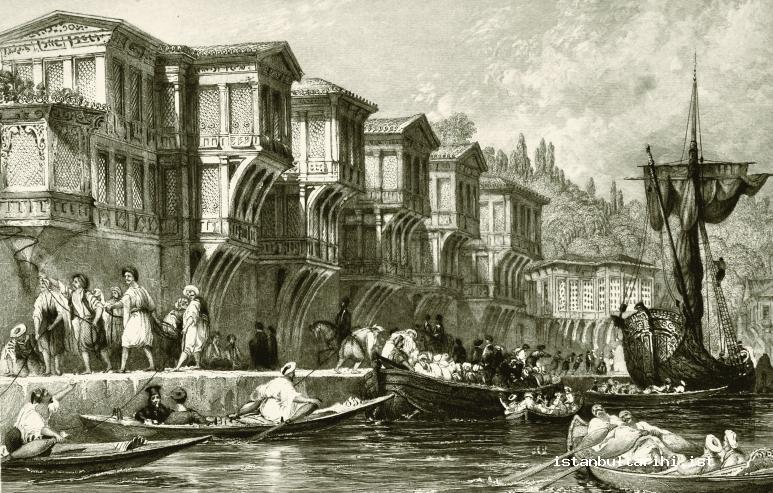
The başkethüda was the chief of all the boatmen kethüdas. The term başkethüda was used in the eighteenth century; however, in the sixteenth and seventeenth centuries this post was most often referred to as the peremeciler kethüdası or kayıkçılar kethüdası. In addition to the integrative role played by the başkethüda in solving administrative and legal problems for the boatmen guilds in all the ports, the main duty of the başkethüda was to hand the rower fees to the port. These fees were collected each year from the boatmen by the port kethüdas. The kethüda had wide-ranging authority over the boatmen, at least as far as the boats were concerned. Even the construction of a new market boat was only possible with the approval of the kethüda and the elder guild members. Generally, the relationship between the boatmen and the state was mediated by the kadı (judge), but sometimes the state could directly assign affairs that concerned the boatmen to the kethüda.
When necessary, meeting the requirements of the state for boats was the responsibility of the kethüdas. Issues such as providing sureties for members of the boatmen’s guild or the professional entry or dismissal of guild members were solely under the authority of the peremeciler kethüdası; the executive authorities (ehl-i örf) were requested not to intervene in such affairs. Port kethüdas were in charge of all the ports’ administrative, legal and social issues. In all the problems concerning the boatmen, the port kethüda was always given a chance to put forward his opinion. The boatmen would relay their demands and complaints to the relevant authorities via the port kethüda. Whenever random inspections were taken the surety of the kethüda and the masters were also counted. The kethüda was in charge of how the boatmen behaved as well as for enforcing codes of practice. If he did not intervene in unlawful acts, he would also be punished.43
In the ports that had no kethüda, the affairs of the boatmen were conducted by the representatives of the kethüda and the elders. The kethüda representatives were located in ports that were outside the center. As with other guilds, there were masters in the boatmen’s guild. Each master worked separately and they were elected from among the master artisans and the experienced long-serving members of the guild. While the older ones were usually masters, it can be understood from the usage of the word müsinn next to the word for elder ihtiyar in the documents that this attribute of elder also meant “distinguished.” This shows that an advanced age was not a prerequisite for being an elder of the guild. The elders served as a consultant in the guilds. The state-imposed system of kefalet (standing surety) meant that the elders stood surety for the boatmen and that the kethüda stood surety for the elders, thus demonstrating that the elders ranked immediately after the kethüda.
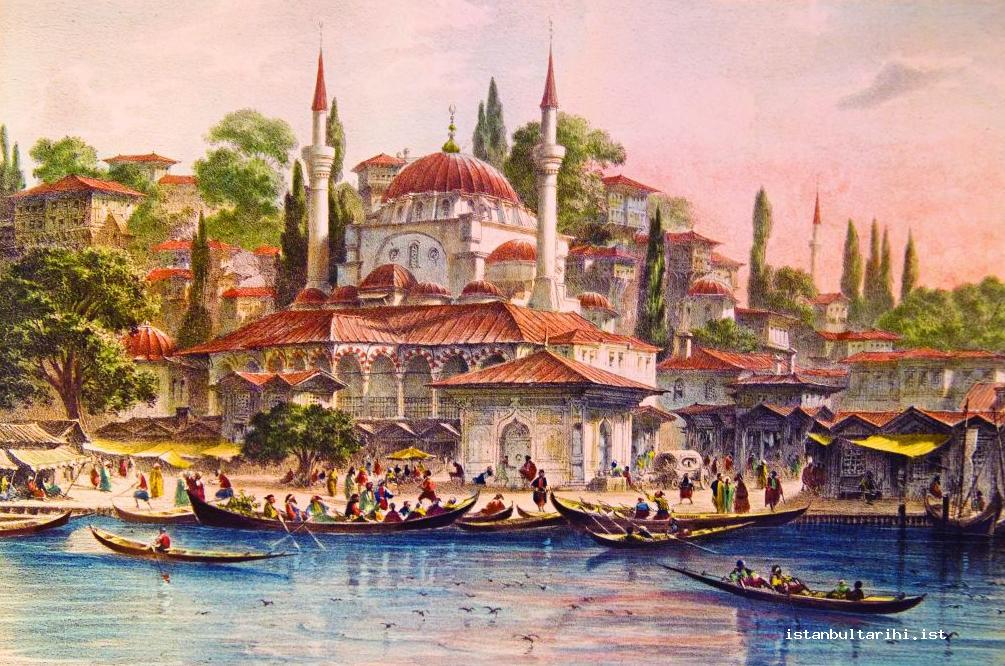
Master boatmen employed apprentices known as şakirt to whom they would teach the skills of the profession. However, employing apprentices without surety was against the regulations if done without the knowledge of the başkethüda or kethüda. It can be understood from other guild regulations that employing a şakirt was subject to some rules. The information in the attendance records reveals that aylakçılar (casual laborers), about whom there is no detailed information, were boatmen who did not own a boat but were working on the boats of others as their services were needed. The aylakçılar were registered at certain ports and had to comply with all the rules that the boatmen did. This is also revealed by the fact that in some of the attendance records these workers were registered without stating that they were aylakçı, and by the fact that the kethüda had to stand surety for the aylakçı.
Because the boatmen could claim certain rights in their relationship to their kethüdas, it can be assumed that there was a democratic environment in the boatmen’s guild. For example, we have evidence that the boatmen could change an unpopular kethüda and negligent ones could be investigated via the courts. However, there were cases where kethüdas made complaints against boatmen. The boatmen in ports that did not have a private kethüda would often ask for one to be allocated to them due to the convenience it provided in conducting affairs with the state, in defending their rights, and due to the benefits that resulted from the rank of the kethüda. In order to be a boatman, one had to serve the master for some time, earn the right to a license, own a separate boat and have a reliable surety. A boatman could not enter this profession by coming from outside the guild without serving as an apprentice. In the first half of the nineteenth century, when there was a surplus of boatmen, which began to damage the social structure, serious measures were taken. Accordingly, men coming from the provinces who wanted to be boatmen were taken to the ihtisap agha by the kethüda of the port at which the man would serve; here he would be registered with his surety.44
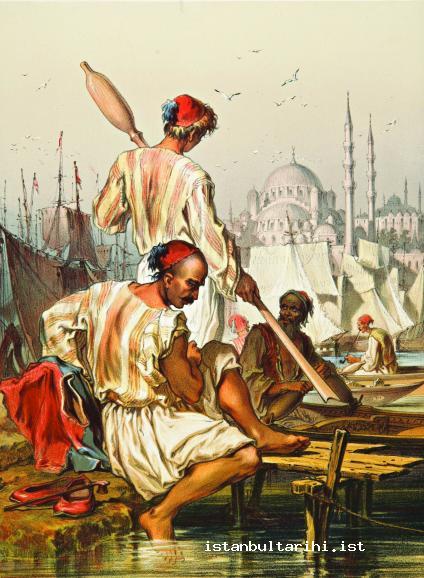

In the middle of the nineteenth century, apprentices had to attain a certificate from their masters and administrators concerning their good conduct and professional eligibility.45 The tribute to be paid by the rower, which was classified as a Tersane Ocaklığı tax, was assessed from those who rowed for state-owned ships. As with other guilds, this tribute was collected from the boatmen’s guild every year. Although the rowers’ fee was a tax collected in kind until the eighteenth century, later this fee was collected in cash. However, some members of the other guilds continued to pay these fees in kind even after the eighteenth century.46 The rower akçe was collected from reaya (tax-paying subjects). The earliest date that this tax was collected was sometime between 1449 and 1500.47 Many decrees were promulgated concerning the collection of rowers’ fees; these can be found in various notebooks in the Istanbul court registers registries, as addressed to the judges.48
The Status of Boatmen in the Social Order
There were many military personnel within the boatmen’s guild. It is possible that the soldiers’ selling the status (esame) to civilians increased these numbers. Sultan Selim III ordered that ten artillerymen be given to every hearth (ocak), the wages of whom were to be acquired from vacant (mahlul) cadres. He was informed that there were no mahlul funds available and that the situation could not change for the next twenty to thirty years. Sultan Selim III described the situation in the following words in an edict issued upon the event:
Allah Allah! What a situation? The right in everything is concealed. Two barbers coming before me are said to possess artillerymen esames. When we need soldiers, they say, “What can we do, we have no soldiers on duty.” When we ask “Can you find a solution?” they say that “Now is not the right time to attack the hearths.” We do not suggest that wages be taken away from everyone, but we should give the mahlul cadres to those who are qualified. If this is not a just word, do not bow to it. May Allah destroy the ones who bow but do not help! This is how this country is lost day by day.49
That the esames were bought and sold like a commodity is supported in the archive sources (esame kasr-ı yedi). According to the information which reveals the state of affairs in the 1790s, virtually all of the boatmen were bostancı or Janissaries. In addition, a large percentage of the shop keepers and other merchants were Janissaries.50 Moreover, it is possible to say that in places where military barracks were located, almost all the boatmen were affiliated with the military. For example, in 1792, 109 boatmen from the artillery were at the Tophane-Sirkeci port. In addition, there were boatmen who served as bostancı at other Tophane ports.
In some of the lists, barrack and squad numbers and other identifying military titles were recorded next to the names of the boatmen who were associated with the military. According to this information, the military affiliated group could include cebecis, artillerymen, bostancıs, other Janissary troops, portyards and retired bostancı, sekbans and other groups. It can be observed that the boatmen were evenly distributed between the military and civilian sectors in the seventeenth century, but this balance was disturbed in favor of the soldiers in the eighteenth century. As late as the beginning of the nineteenth century, the number of military boatmen fell below 50 percent. In 1677, of the 1,366 boats working in the Istanbul ports, 577 belonged to the military and 789 belonged to the public or civilians. Considering that of these 789 boats, nearly 100 belonged to non-Muslims, the ratio is actually balanced between soldiers and civilians.51 In 1751, of the 2,852 Muslim boatmen working on all Istanbul ports outside of Üsküdar and Kadıköy ports, 2,011 were in the military. We can arrive at this figure with the help of an ocak name, squad number or other title indicating military rank that occur in the lists of boatmen. It is also possible that boatmen whose names did not bear any of these indications in the surviving lists could also be military. After this point in time, this number might have increased slightly. According to a census conducted in 1802, of the 5,151 Muslim boatmen, 2,063 were from the military and 3,088 were civilians.
Because so many boatmen were affiliated with the military, it was difficult to organize and control their order. In fact, if a çifte boat made journeys between the Beşiktaş and Ortaköy ports, it required six people to operate it; if two çifte boats were used, then ten people would be required. However, the qadi emphasized that in order to implement these rules, the situation should be reported to the bostancıbaşı, as most of these boatmen were from the hassa bostancısı corps.52 The gedik institution, which was concerned with the authority to carry out this profession and conduct trade, also operated with the boatmen’s guild as well.53 Indeed, everything that was used in trade fell within the scope of the gedik system. The defenders of the gedik system were none other than the members of the institution. The craftsmen in the guilds strove to keep their numbers the same, because they thought that every new craftsman would reduce their earnings. However, it was obvious that through favoritism, unfair appointments were made to the gediks. In fact, on February 28, 1764, Hasköy and the kethüda of the affiliated port, along with the Eyüp port kethüda and başkethüda lodged a complaint about unwelcome people at the ports who were violating the regulations and entering the ports, disturbing the customers. The people in question were in fact investigated, and the kethüdas even received assurances that if one of the boatmen died or his place fell vacant no new boatman would be hired, and that the port’s share would be met.54
Finding Sureties for Boatmen
Guaranteeing the surety for the boatmen basically came under the authority of the kethüda; boatmen were not charged for this surety. A decree dated September 2, 1583 states that some officials from the ehl-i örf were approving sureties for boatmen by charging them fees, in violation of the rules. The document continues that the persons who issued these illegal sureties could not be found when necessary, and it was emphasized that the sole authority for approving sureties was the kethüda.55 Indeed, from this time until the nineteenth century, permission was not given for any sureties to be approved without the knowledge of the kethüda.
The Dexterity of Boatmen
The general opinion of foreign travelers who visited Turkey during the Ottoman era was that the boatmen were skillful and the boats were fast. Although there seems to have been a leaning in favor of the piyade to the gondola, the opinion about the boatmen was always positive. Bets were even placed on the prowess of Turkish boatmen.56 Foreign officials and travelers raved about the boatmen they had come to know.57 The operators of the graceful and beautifully adorned boats that moved without cessation along the Bosphorus were masters who knew how to guide the boats very skillfully.58
Using these easily-capsized boats was a matter that required competence. Slade emphasizes the skills of the Ottoman boatmen when he describes the feelings of first-time passengers:
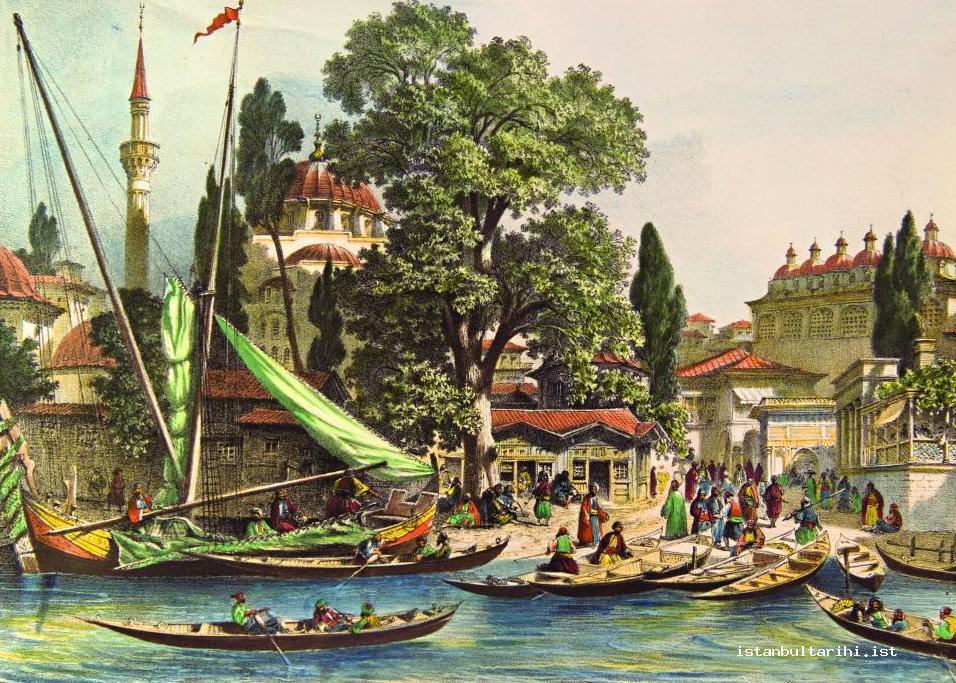
Europeans, residents of Pera who have a flattering concept of their own personal value, seldom venture into one. No sooner do you step into one than, feeling prescient of a drowning, you endeavor to step out again; the attempt nearly completes the catastrophe. “Sit down!” cry the caikgis authoritatively. You obey, and place yourself on what appears to be a seat, but rather than gaining steadiness, the bark reels to an inch of the water each way. “Sit down in the bottom of the boat!” shout the caikgis again, who, half frightened, endeavor to counteract your awkwardness by balancing their supple bodies: “sit quietly unless you wish the boat to be over you instead of under you!” You cast a longing look at the shore and, exclaiming at your rashness, you shove off, doubtful if you will land again.59
Despite the view that these boats could easily capsize, thousands of expeditions were made without any accident up and down and across the Bosphorus; the protective measures and the deftness in approaching and mooring the boats inspired confidence. If one of these vessels capsized, even if there were a hundred boats available, the passengers would still drown; no one could have been helped, and an attempt to save them would have been suicide.60 According to a report from the end of the eighteenth century, although the Turks could not pilot large ships, they were much better at sailing the long and narrow boats than people of other nationalities,61 and they were more skillful in their boats than Christian or Jewish boatmen.62 However, by the middle of the nineteenth century, the dominant conviction around the Bosphorus was that the Greeks were the best boatmen.63
The dexterity of the boatmen partly resulted from their familiarity with the Bosphorus currents. For instance, while travelling from the Golden Horn to Üsküdar, by following the Rumelia coast rather than going in a straight line, they would reach Dolmabahçe; then, by taking advantage of the current, they could easily arrive in Üsküdar.64 The boatmen displayed their skills in very crowded port entrances and exits as well. At certain hours the ports would be crowded with innumerable boats, rowing back and forth. They would queue, one after the other, and the boatmen would continue ahead, ignoring the warnings of the other boatmen, stepping on the left side of the boat, or clinging to the rear in a seemingly intractable mess. Despite the difficulty of navigating such a situation, rarely did one boat hit another, and occurrence of serious accidents was very seldom.65 The organized maneuvers in this complexity also astounded Miss Pardoe:
Among the vessels of war, merchant ships and steam packets the slender caiques of polished and carved walnut, with the gracefully clad rowers and intricately gilded ornaments, glittering in the light darted, glided and whirled; the sharp shrill cry of “European shore!”, “Asiatic shore!” --the boatmen indicated to one another which course to steer so that all would have a free passage.66
Number of Boatmen
The number of Istanbul boatmen was established67 in detail in different centuries and here an overall evaluation will be given. There are some difficulties in comparing all the ports by century. In fact, an individual comparison of ports might not be meaningful because the numbers we have are inconsistent: there is a great difference between the censuses made at different times. More than one port could be counted as only one in some sources, and the number of ports increases over time. Therefore, in order to draw comparisons about the number of ports and boatmen, Istanbul has been divided into eight regions, according to the date. Existing ports are specified in each region and some of the principal ports are compared more thoroughly. The censuses for the ports of Beşiktaş, Ortaköy, Kuruçeşme, Arnavutköy, Çengelköy and İstavroz are sometimes made together, as these ports were affiliated with the main ports of Beşiktaş and Ortaköy. This factor has been taken into consideration.68
Region 1 Ports: Samatya, Davutpaşa, Langa (Bostan, Provinces) Yenikapısı, Kumkapı, Çatladıkapı and Ahırkapı ports. In 1677 there were 119 boatmen; in 1728 there were 230; in 1751 there were 409; in 1792 there were 347 boatmen, and in 1802 there were 325 boatmen.
Region 2 Ports: Bahçekapı, Bab-ı Şuhud, Ayazmakapı, Unkapanı, Cibali Yenikapı, Fener, Balat and Ayvansaray ports. In 1677 there are 351 boatmen.
Bahçekapı Port boatyards, Istanbul Agha, Unkapanı, Cibali Ayakapı and Yenikapı, Fener and Balat ports. In 1728 there were 653 boatmen.
Bahçekapı Port boatyards, Bahçekapı, Istanbul Agha, Landfill, Unkapanı, Cibali Ayakapı and Yenikapı, Fener, Balat and Ayvansaray ports. In 1751 there were 865 boatmen.
Bahçekapı Port boatyards, jetty, Agha Tulumba Istanbul, Istanbul Agha, Salhane, Eminönü, Emtia Gümrüğü (Commodities Customs), Çardakönü, Hasır, Odunkapı Tulumba, Unkapanı, Cibali, Cibali Yenikapısı, Fener and Balat ports. In 1792 there were 729 boatmen.
Bahçekapı Port boatyards, Bahçekapı, Agha Tulumba Istanbul, Istanbul Agha, Salhane, Eminönü, Gümrükte Duhan, Istanbul and Galata customs boatmen without a port, Hasır, fellow boatmen with Ellialtı Kolluk in front, Odunkapı, Unkapanı, Cibali, Yenikapı, Fener, Balat ports, In 1802 there were 853 boatmen.
Region 3 Ports: Eyüp, Defterdar and Hasköy ports. In 1677 there were 161 boatmen.
Eyüp, Defterdar, Hasköy, Sütlüce, Portyard, Karaağaç gardens and gardeners’ ports. In 1728 there were 583 boatmen.
Eyüp, Defterdar, Defterdar Başdankaracıları, Hasköy and Sütlüce ports. In 1751 there were 467 boatmen.
Eyüp Great and Defterdar ports. In 1794 there were 118 boatmen (As Hasköy and Sütlüce are not included here, the number decreases. In 1752 the number of Hasköy-Sütlüce ports’ boatmen was 310).
Defterdar, Eyüp, Eyüp-Bostancı boatmen, Sütlüce and Kışlaönü Humbaracı boatmen, old Sütlüce port boatmen, Bozahane and Halıcıoğlu, Piri Pasha Bath, Karaağaç Barracks Boatmen, Salhane, Hasköy, Portyard Garden Barracks’ Boatmen ports. In 1802 there were 665 boatmen.
Region 4 Ports: Kasımpaşa, Azapkapı and Karaköy. In 1677 there were 307 boatmen.
Aynalıkavak, Kasımpaşa, the boatmen working in front of the shipyard cellar, boatmen working in the shipyard, Azapkapısı, Meyyit, Minor, Kürkçükapısı, Galata Balıkpazarı, Karaköy, Mumhane and Kurşunlumahzen Ports. In 1728 there were 695 boatmen.
Aynalıkavak, Mahzen-i Çöp, Camiönü, Aralıklar, Kasımpaşa, Meyyit, Karhaneönü, Aralık, Azapkapı, Kürkçükapı, Balıkhane, Galata Eski Kapan, Galata Balıkpazarı, Karaköy, Kurşunlumahzen, port near Mumhane, Mumhane Port. In 1752 there were 671 boatmen.
Kasımpaşa, boatmen of the Shipyard, boatmen residing at Meyyit Port Kalafatçı Barracks, Meyyit, Azapkapı, boatmen in Cabali (?), boatmen in Ayazma, Kürkçükapı, Galata Balıkpazarı, Old Yağkapanı, Balıkhane, Karaköy, Kurşunlumahzen, Aralık and Mumhane ports. In 1792 there were 583 boatmen.
The Mandacı boatmen next to the galleys in the shipyard, Divanhane, Kalyoncu boatmen, the port in front of the Kalyoncu barracks, the boatmen of the shipyard workers, Meyyit, Azapkapı, Funda and Ayazkapısı place, Kürkçükapı, Eski Yağkapanı, Galata Fishmarket, kalyoncu boatmen working in front of the fishermen, Karaköy and Kurşunlumahzen ports. In 1802 there were 1,206 boatmen.
|
Table 1- Comparison of boatmen at different dates by region: |
|||||||
|
Region |
1535 |
1568 |
1677 |
1728 |
1751-1752 |
1792-1794 |
1802 |
|
1 |
|
|
119 |
230 |
409 |
347 |
325 |
|
2 |
|
|
351 |
653 |
865 |
729 |
853 |
|
3 |
|
|
161 |
583 |
467 |
118 |
665 |
|
4 |
|
|
307 |
695 |
671 |
583 |
1.206 |
|
5 |
|
|
201 |
441 |
587 |
461 |
855 |
|
6 |
|
|
61 |
189 |
424 |
483 |
685 |
|
7 |
|
|
18 |
58 |
|
85 |
106 |
|
8 |
10 |
40 |
|
748 |
|
570 |
830 |
|
9 |
|
|
|
|
|
402 |
660 |
|
10 |
|
|
|
|
|
189 |
371 |
|
Total |
|
|
1.218 |
3.597 |
3.423 |
3.967 |
6.556 |
|
Table 2- For the same period, the number of boats: |
|||||
|
Region |
1677 |
1728 |
1751-1752 |
1792-1794 |
1802 |
|
1 |
123 |
157 |
190 |
|
248 |
|
2 |
392 |
421 |
420 |
|
658 |
|
3 |
168 |
420 |
|
|
534 |
|
4 |
387 |
654 |
|
|
971 |
|
5 |
209 |
312 |
|
|
566 |
|
6 |
67 |
159 |
|
|
379 |
|
7 |
20 |
27 |
|
|
30 |
|
8 |
|
333 |
|
|
287 |
|
9 |
|
|
|
|
358 |
|
10 |
|
|
|
|
214 |
|
Total |
1.366 |
2.483 |
|
|
4.245 |
Region 5 Ports: Tophane, Fındıklı, Mehmet Aga and Kireçkapı. In 1677 there were 201 boatmen.
Tophane, Salıpazarı, Fındıklı, Karayalı and Eğrikapı ports. In 1728 there were 441 boatmen.
Tophane, Orta, Sirkeci, Büyük, Salıpazarı, Fındıklı, Kabataş and Dolmabahçe ports. In 1752 there were 587 boatmen.
Tophane-Sirkeci, Çeşmeardı boatmen, Sirkeci, Eğrikapı, Toplarönü, Salıpazarı, Hamallar, Fındıklı, Camiönü and Kabataş Jetties. In 1792 there were 461 boatmen.
Tophane-Sirkeci, Tophaneyeri, Toplarönü, Salıpazarı, Fındıklı, Kabataş, Karayalı, Dolmabahçe and Arap ports. In 1802 there were 855 boatmen.
Region 6 Ports: Beşiktaş, Ortaköy, Kuruçeşme, Arnavutköy, İstavroz and Beylerbeyi, Çengelköy Ports. In 1677 there were 61 boatmen; in 1728 there were 189 boatmen; in 1752 there were 424 boatmen; in 1792 there were 483 boatmen; and in 1802 there were 685 boatmen.
Region 7 Ports: Kadıköy Port. In 1677 there were 18 boatmen; in 1728 there were 58 boatmen; in 1792 there were 85 boatmen; and in 1802 there were 106 boatmen.
Region 8 Ports: Üsküdar Great Port, Balaban, Salacak and Kuzguncuk ports. In 1728 there were 748 boatmen.
Üsküdar Great Port, Mumhane, Balaban, Kavak, Salacak, İhsaniye, Ayazma and Kuzguncuk ports. In 1792 there were 570 boatmen.
Mumhane 62, Tophaneyeri 110, Dört Çifteler at the Great Port 112, on duty boat 17, horse barges 107, fire boats 21, Balaban Port piyades 95, Üsküdar horse barges in front of Istanbul Customs, kalyoncu boatmen at the large port 101, Ayazma Port bostancı and the elders 53, Salacak and İhsaniye bostancı and elders 23 and Kuzguncuk 80 boatmen. In 1802 there were 830 boatmen.
Region 9 Ports. Bebek, Emirgan, Rumeli Fortress, İstinye, Yeniköy, Tarabya, Büyükdere, Sarıyer and Rumelikavağı ports. In 1802 there were 660 boatmen and 358 boats.
Region 10 Ports. Kandilli, Anadoluhisarı, Kanlıca, Paşabahçe, Beykoz, Yuşa and Anadolukavağı ports. In 1802, 371 boatmen and 214 boats.
Finally, below the number of all the boatmen in Istanbul at different dates are compared. Bargemen have also been included.69
In these evaluations political and social factors that contributed to an increase in the number of boatmen should be taken into consideration. As known, in the sixteenth century the Celali riots, which took place in Anatolia, caused people who were engaged in agriculture to leave their lands and migrate to Istanbul. This situation led to the deterioration of public order. In a city like Istanbul, whose subsistence came almost entirely from other cities, famine and inflation occurred.70 Most of the time, people coming from Anatolia disrupted the public order because they were unable to find jobs, thus causing discontent among the residents. For this reason, at the beginning of the century, many measures were taken to prevent migration to Istanbul, and as a result, the increase in the number of the boatmen slowed down relatively. Although not included in the table above, a census was carried out in 1726. A census made just a few years later provides evidence that the state was in a way predicting the revolt of 1730. Sultan Mahmud I, imperturbable in this regard, took serious measures to prevent people coming from Anatolia. One reason for the sudden slowdown after 1728 in the number of boatmen was most probably a result of the measures taken to prevent a rebellion, like the one that was to happen in 1730. Indeed, after the second half of the eighteenth century, the guilds had to stand mutual surety to a degree that had never been encountered in previous years. For this reason, while the average growth rate in the 51 years between 1677 and 1728 was 150 percent, in the 64 years between 1728 and 1792 there was almost no increase. Almost ten years later, an increase in the number of boatmen of approximately 38 percent probably originated from the fact that Janissaries and military corps were not forced to make certain changes, despite some other reforms carried out during the reign of Sultan Selim III.
While it is certain that censuses were carried out after 1802 in order to identify the number of boatmen, the details of these have not yet been discovered.71 If this information is found, it would be possible to document the decline in the number of boatmen following the abolition of the Janissary corps. Immediately after the abolition of the Janissary corps, many boatmen were expelled to Anatolia, as they were registered with the Janissary corps and thus viewed with suspicion. It is certain that the number of boatmen decreased after 1826. Though measures aimed at migration were relaxed during the Tanzimat period, ferries started operating at around the same time, making it likely that there was no increase in the number of boatmen.
However, some information which is difficult to substantiate at the present time raises the possibility that even in the middle of the nineteenth century the number of boatmen was very high. Estimates of this type, like the information provided by Evliya Çelebi in the seventeenth century, are often exaggerated. In fact, according to Evliya Çelebi, there were 7,000 boatmen, while there were 8,000 peremeci and the number of pereme was 4,163.72 However, according to a census taken in 1677, the number of boatmen was 1,218 and the number of boats was 1,366.73 Yet, according to White, the number of boatmen who served in the vicinity of Galata, the areas surrounding Dolmabahçe and the number of boatmen registered in the city kayıkçıbaşı register is about 19,000, while there were 16,000 boats. The number of boats and boatmen that were registered to Bosphorus villages and which went to Dolmabahçe, Üsküdar and the Black Sea should be added to these figures. According to the claims of the village captain and mooring masters, about 5,000 boatmen were working and there were 3,000 boats operating in that era. In this case, the number of boatmen operating between the Black Sea and Yedikule rose to 24,000 and the number of boats to 19,000.74 Although White states that the number of boatmen was registered in the kayıkçıbaşı register, he does not indicate that he attained this information from these registers. Moreover, when the claim of 6,500 boatmen in 1802 is compared to the number in other centuries, a 269 percent increase over 42 years gives us pause. According to another foreign observer, in the Istanbul Port and the Bosphorus villages in 1777 there were 5,700 private and public boats, of a variety of sizes.75 Considering that the number of public boats in 1802 was 4,245, this estimate is quite realistic, and the growth rate invalidates the figures that White provides. Even though there was not a huge increase after the commencement of the ferry service, the boatmen formed the most populated guild.76
In determining passenger fees, there are a number of criteria to be considered.77 In 1681 a narh (state-fixed price) per day was established for the boatmen; this was based on the destination.78 Again, the destination naturally affected the fee; even rowing against the tide between the same ports increased it. For example, in 1681 the narh for going to Üsküdar from Eminönü was 6 akçe, but from Eminönü to Üsküdar on a çifte boat it was 8 akçe. Moreover the boatmen did not want to go to destinations where they would not be able to find passengers for the return trip.79
Until the establishment of the Şirket-i Hayriyye travel on the Bosphorus was not very important. However, long-standing entertainment and excursion areas were located along the water, and people who could afford to spend time and money took part in the entertainment scene of the Bosphorus. Statesmen and rich residents had mansions and manors on the Bosphorus which, until the reign of Sultan Abdulmecid, were serviced by galleys and other çifte boats. However, due to the inadequacy of the boats traveling along the Bosphorus, it was impossible for the middle class and commuting officers to settle here. The main inhabitants of the Bosphorus were people engaged in fishing and boating. The establishment of Şirket-i Hayriyye affected the boatmen as well as the social life of Istanbul. With the commencement of Şirket-i Hayriyye ferries along the Bosphorus, coastal homes gained in value and property on the Bosphorus became more sought after.
CONCLUSION
The use of ferries for maritime transportation was one of the most important factors that can increase the dynamism of a city. However, this does not refer to merely an increase in vehicular patterns, but also to the effect on habits of the people throughout the day. The reasons for the increase in the daily dynamism depend on a number of factors, for example, the unavoidable cycle of the modern production-consumption relationship; thus the completion of this cycle is somehow inevitable. The areas that are accessible to transportation will sooner or later experience differences and changes. However, even today, particularly when we take into consideration the Bosphorus ports and external lines, maritime business in Istanbul is still insufficient. At the same time, land transport problems can never be solved adequately, thus taking us back to the maritime alternative for the time being. Considering that Turkey is a country surrounded by water on three sides, maritime travel is a transportation alternative the benefits of which have not been sufficiently exploited. After a simple assessment, the most significant reason for this deficiency is a pragmatist view which takes into account the fact that a one-hundred passenger ferry will not make a profit if it operates with only ten passengers. However, by operating smaller vehicles that make more trips, a convenient traffic pattern could be formulated. Throughout history, intertwined and complementary social structural elements have been formed by a web of social relations. Therefore, just as in other domains, we should keep in mind that transport should be planned not by a political commission, but by an advisory think-tank that adopts a holistic perspective, thus properly being able to assess economic and cultural values and factors.
FOOTNOTES
1 Halil İnalcık, Fatih Devri Üzerinde Tetkikler ve Vesikalar I, Ankara: Türk Tarih Kurumu, 1987, pp. 121-122.
2 For information about the Istanbul ports, their operation and the coasts before the conquest, see: Wolfgang Müller-Wiener, Bizans’tan Osmanlı’ya İstanbul Limanı , translated by Erol Özbek, Istanbul: Türkiye Ekonomik ve Toplumsal Tarih Vakfı, 1998, pp. 1-42.
3 Müller-Wiener, Bizans’tan Osmanlı’ya İstanbul Limanı, pp. 6-12. For Istanbul ports, see: Mehmed Ziya, İstanbul, Boğaziçi, Istanbul: Maarif-i Umûmiye Nezareti, 1336, vol. 1, pp. 472-486.
4 Semavi Eyice, Bizans Devrinde Boğaziçi, Istanbul: İstanbul Üniversitesi Edebiyat Fakültesi, 1976, p. 12.
5 Ekrem Hakkı Ayverdi, Fatih Devri Sonlarında İstanbul Mahalleleri, Şehrin İskânı ve Nüfusu, Ankara: Vakıflar Umum Müdürlüğü, 1958, pp. 4-5.
6 Müller-Wiener, Bizans’tan Osmanlı’ya Istanbul Limanı, pp. 132, 143.
7 Hezarfen Hüseyin Efendi, Telhisü’l-beyan fi Kavanin-i Al-i Osman, edited by Sevim İlgürel, Ankara: Türk Tarih Kurumu, 1998, p. 54.
8 Eremya Çelebi Kömürcüyan, Istanbul Tarihi, XVII. Asırda Istanbul, tr Hrand D. Andreasyan, Istanbul: Istanbul Üniversitesi Edebiyat Fakültesi, 1952, p. 16.
9 Kömürcüyan, Istanbul Tarihi, p. 43.
10 Tülay Reyhanlı, İngiliz Gezginlerine Göre XVI. Yüzyılda Istanbul’da Hayat, Ankara: Kültür ve Turizm Bakanlığı, 1983 1983, pp. 27, 43.
11 P. Ğ. İncicyan, 18. Asırda Istanbul, translated by Hrand D. Andreasyan, Istanbul: Istanbul Fetih Derneği Istanbul Enstitüsü, 1976, p. 102.
12 Nejdet Ertuğ, Osmanlı Döneminde İstanbul Deniz Ulaşımı ve Kayıkçılar, Ankara: Kültür Bakanlığı, 2001, p. 225.
13 A Spanish traveler describes Galata as: “the captain and the sailor, seamen all live in Galata...Galata is a town of four thousand people. All the Venetian and Florentine Bezirgans live here. It must be around a thousand houses”, (Türkiye’nin Dört Yılı 1552-1556, Manuel Serrano Y. Sanz’s manuscript published in 1905 (tr. A. Kurutluoğlu, İstanbul, undated).
14 Nicolas de Nicolay, The Navigations into Turkey, London 1585, facsimile, Amsterdam: Da Capo Press, 1968, p. 46b.
15 Nicolay, The Navigations, p. 65a.
16 Reyhanlı, İngiliz Gezginlerine Göre XVI. Yüzyılda İstanbul’da Hayat, p. 43.
17 İdris Bostan, Osmanlı Bahriye Teşkilatı: XVII. Yüzyılda Tersane-i Amire, Ankara: Türk Tarih Kurumu, 1992, pp. 3-7. For the Tersane-i Amire see: Müller-Wiener, Bizans’tan Osmanlı’ya İstanbul Limanı, pp. 44-51.
18 Necla Arslan, Gravür ve Seyahatnameler’de İstanbul, Istanbul: İstanbul Büyükşehir Belediyesi Kültür İşleri Daire Başkanlığı, 1992, pp. 48-54. For ports and views of boats, see Çelik Gülersoy, Kayıklar, Istanbul: Cem Yayınevi, 1983. Again for ship miniatures, see Ülker Erke, Minyatürlerde Gemiler, text by Hasan Ali Göksoy, Ankara: Kültür Bakanlığı, 1997.
19 Tursun Bey, Târîh-i Ebü’l-Feth, edited by Mertol Tulum, Istanbul: İstanbul Fetih Cemiyeti, 1977, p. 75.
20 Münevver Alp, “Eski Eyüb Sultan”, TFA, 1963, vol. 8, pp. 172, pp. 3231-3235.
21 Edwin A. Grosvenor, Constantinople, Boston: Roberts Brothers, 1895, vol. 1, pp. 77-78.
22 Mübahat S. Kütükoğlu, Osmanlılarda Narh Müessesesi ve 1640 Tarihli Narh Defteri, Istanbul: Enderun Kitabevi, 1983, p. 286.
23 Ertuğ, Osmanlı Döneminde İstanbul Deniz Ulaşımı, p. 212.
24 Cahit Kayra and Erol Üyepazarcı, İkinci Mahmud’un İstanbul’u, Bostancıbaşı Sicilleri, Istanbul: İstanbul Büyükşehir Belediyesi, 1992, pp. 93-156.
25 Sarkis Hovhannesyan, Payitaht İstanbul’un Tarihçesi, tr. Elmon Hançer, Istanbul: Tarih Vakfı Yurt Yayınları, 1996, p. 24.
26 Reşat Ekrem Koçu, “Balat Sahili”, İA, vol. 4, 1974.
27 Necib, İstanbul Rehberi, Istanbul 1334/1918, map section 1. For coastal plans and the topography of the harbor zone and functions of the ports, see: Müller-Wiener, Bizans’tan Osmanlı’ya İstanbul Limanı, pp. 159-185.
28 For example, the Kars ferry of the İdare-i Mahsusa, which set out for Thessaloniki from the Golden Horn with 205 passengers, sank after colliding with the Istanbul-bound Bahire ferry of the Hidiviye Ferries (Ahmed Lutfî Efendi, Vak‘anüvis Ahmed Lutfi Efendi Tarihi, ed. Münir Aktepe, Ankara: Türk Tarih Kurumu, 1993, vol. 15, p. 21). Several sea disasters are mentioned in Takvim-i Vekayi (19 Zilkade 1266, no. 432). For sea disasters, also see: Müller-Wiener, Bizans’tan Osmanlı’ya İstanbul Limanı, pp. 110, 146.
29 Münir Aktepe, “İstanbul Fenerbahçesi Hakkında Bazı Bilgiler”, TD, no. 32 (1979), pp. 354-356.
30 Müller-Wiener, Bizans’tan Osmanlı’ya İstanbul Limanı, pp. 53-55.
31 Ertuğ, Osmanlı Döneminde İstanbul Deniz Ulaşım, p. 220.
32 Müller-Wiener, Bizans’tan Osmanlı’ya İstanbul Limanı, pp. 122-126. In order to prevent ships from running ashore, buoys were installed in 1872. Also, the insufficient number of mooring blocks caused accidents very often, and in 1873 mooring buoys were ordered and placed on the sea. (Müller-Wiener, Bizans’tan Osmanlı’ya İstanbul Limanı, pp. 133-134).
33 Jan Thevenot, 1655-1656’da Türkiye, tr. Nuray Yıldız, Istanbul: Tercüman Gazetesi, 1978, p. 58.
34 Thevenot, 1655-1656’da Türkiye, p. 77.
35 Gerard de Nerval, Muhteşem İstanbul, tr. Refik Özdek, Istanbul: Boğaziçi Yayınları, 1974, p. 17.
36 Adolphus Slade, Records of Travels in Turkey: Greece and of a Cruise in the Black Sea with the Capitan Pasha, in the Years 1829, 1830 and 1831, 2 vol., London: Saunders and Otley, 1832, vol. 1, p. 145. Moltke, in 1836, stated that it took one and a half hours to go from Büyükdere to Istanbul, but due to the current the return journey took three and a half hours. (Moltke’nin Türkiye Mektupları, tr. Hayrullah Ors, Istanbul: Remzi Kitabevi, 1995, p. 94). Around the same year, the American sailor Colton preferred to travel to the Black Sea in a boat with six oars instead of by horse (Walter Colton, Visit to Constantinople and Athens, New York: Lord & Co ., 1836, pp. 123-129).
37 Adolphus Slade, Turkey, Greece and Malta, 2 vol., London: Saunders and Otley, 1837, vol. 2, p. 226.
38 W. Eton, A Survey of the Turkish Empire, London: Printed for T. Cadell, Jun. and W. Davies, 1799, p. 228.
39 Robert Walsh, A Residence at Constantinople, during a Period Including the Commencement, Progress, and Termination of the Greek and Turkish Revolutions, 2 vol., London: R. Bentley, 1838, vol. 1, p. 269.
40 Ertuğ, Osmanlı Döneminde Istanbul Deniz Ulaşımı, p. 235.
41 BOA, MD, 3, pp. 498, 1480; no. 4, p. 116, h. 1180, 21 Za 967/ August 13, 1560.
42 Mübahat S. Kütükoğlu, “Osmanlı Esnafında Oto-kontrol Müessesesi”, Ahilik ve Esnaf, Istanbul: Esnaf ve Sanatkarlar Dernekleri Birliği, 1986, p. 60.
43 Ertuğ, Osmanlı Döneminde İstanbul Deniz Ulaşımı, pp. 9-12.
44 Ertuğ, Osmanlı Döneminde İstanbul Deniz Ulaşımı, pp. 19-21.
45 Charles White, Three Years in Constantinople or Domestic Manners of the Turks in 1844, 3 vol., London: H. Colburn, 1846, vol. 1, p. 52.
46 Ertuğ, Osmanlı Döneminde İstanbul Deniz Ulaşımı, p. 23.
47 Bostan, Osmanlı Bahriye Teşkilatı, p. 187.
48 Ertuğ, Osmanlı Döneminde İstanbul Deniz Ulaşımı, p. 23
49 Ziya Karamursal, Osmanlı Mali Tarihi Hakkında Tetkikler, Ankara: Türk Tarih Kurumu, 1989, p. 71.
50 Eton, A Survey of The Turkish Empire, p. 282.
51 Ertuğ, Osmanlı Döneminde İstanbul Deniz Ulaşımı, p. 29.
52 Ertuğ, Osmanlı Döneminde İstanbul Deniz Ulaşımı, p. 30.
53 Osman Nuri Ergin, Mecelle-i Umûr-ı Belediyye, Istanbul: Matbaa-i Osmaniye, 1338, vol. 1, p. 652.
54 Ertuğ, Osmanlı Döneminde İstanbul Deniz Ulaşımı, p. 31.
55 Ertuğ, Osmanlı Döneminde İstanbul Deniz Ulaşımı, p. 33.
56 Ubicini describes the event as follows: “One day (a few years before the French Revolution) a discussion ensued in front of the Venetian ambassador in Turkey; here it was stated that the mastery and the speed of Turkish boatmen could by no means be compared to that of other nations. The ambassador defended the superiority of Venetian gondoliers and English ambassador Chevalier Amshey accepted a bet. The amount of money was large. A period of time was given to the ambassador of Venice to bring the gondoliers; they arrived in the spring. A race was held and the Turks won.” (Jean Henri A. Ubicini, 1855’de Türkiye, tr Ayda Düz, Istanbul: Tercüman Gazetesi, 1977, vol. 2, pp. 82-83).
57 George Larpent, Turkey, Its History and Progress from the Journals and Correspondence of Sir James Porter, London: Hurst & Blackett, 1854, v. 2, p. 401.
58 William Wittman, Travels in Turkey, Asia-Minor, Syria and Across the Desert into Egypt, London: Printed for J. Asperne, 1803, p. 15.
59 Slade, Records of Travels, vol. 1, p. 112.
60 Slade, Records of Travels, v. 1, p. 114.
61 Eton, A Survey of The Turkish Empire, pp. 83, 84. Hezarfen Hüseyin Efendi’s views on the lagging of Turkish maritime in the seventeenth century are striking: “ In the Imperial Shipyard, there remained no one who travelled all of the Mediterranean. There remained very few people who have the ability to use a compass in order to determine height and to use a map. Rare are those who know the conditions of wind, can use a compass to determine the direction and have the ability to steer ship properly in the inclement weather. The dignitaries do not honor the experts of this science; students are not interested in it. Thus, as the situation in other career parts, practitioners of this profession fell far away from competence and expertise. (Eton, A Survey of The Turkish Empire, p. 160). For the reasons why the Ottomans lagged behind at the end of the eighteenth century and the rectification of the situation, see Mahmud Raif Efendi, Osmanlı İmparatorluğunda Yeni Nizamların Cedveli, tr. Arslan Terzioğlu and Hüsrev Hatemi, Istanbul: Türkiye Turing ve Otomobil Kurumu, 1988, pp. 24-30.
62 Eton, A Survey of The Turkish Empire, p. 230.
63 Miss Pardoe, The City of The Sultan, London: Routledge, 1854, p. 230.
64 William Francis Ainsworth, Travels and Researches in Asia Minor, Mesopotamia, Chaldea and Armenia, London: John W. Parker, 1842, v. 1, pp. 9, 12. Due to the rapid current while rowing up the Bosphorus, boats needed to cross carefully when going to the European side. (Moltke, Türkiye Mektupları, p. 34.)
65 White, Three Years in Constantinople, vol. 1, p. 36.
66 Pardoe, The City of the Sultan, pp. 122, 123.
67 Ertuğ, Osmanlı Döneminde İstanbul Deniz Ulaşımı, pp. 109-134.
68 For detailed censuses and information on boatmen see: Ertuğ, Osmanlı Döneminde İstanbul Deniz Ulaşımı, pp. 135-144.
69 In the study about the number of boatmen, bargemen were not included in the total as they did not carry passengers. However, in the table: “The number of boatmen at different dates by region” all boatmen were included, including bargemen and lightermen. This table can be found in Ertuğ, Osmanlı Döneminde İstanbul Deniz Ulaşımı, pp. 135-144.
70 Halil İnalcık, “İstanbul”, EI2 (Eng.), vol 5, pp. 240-242; For detailed information on cases of banditry in Anatolia, its emergence, social reflections and connection with migration, see: Mustafa Cezar, Osmanlı Tarihinde Levendler, Istanbul 1965. For further information on economic upheavals, their causes and consequences, and the measures taken in response to them, see: Yusuf Halaçoğlu, XVIII. Yüzyılda Osmanlı İmparatorluğu’nun İskân Siyaseti ve Aşiretlerin Yerleştirilmesi, Ankara: Türk Tarih Kurumu, 1991, pp. 28-124.
71 Ertuğ, Osmanlı Döneminde İstanbul Deniz Ulaşımı, pp. 142.
72 Evliya Çelebi, Travel, Istanbul 1314, vol. 1, p. 553.
73 Ertuğ, Osmanlı Döneminde İstanbul Deniz Ulaşımı, pp. 143.
74 White, Three Years in Constantinople, vol. 1, p. 51.
75 Eton, A Survey of the Turkish Empire, p. 288.
76 Ubicini, 1855‘de Türkiye,, vol. 2, p. 82.
77 For detailed information on passenger fees in Istanbul in different periods, see: Ertuğ, Osmanlı Döneminde İstanbul Deniz Ulaşımı, pp. 144-175.
78 Ertuğ, Osmanlı Döneminde İstanbul Deniz Ulaşımı, p. 148.
79 White, Three Years in Constantinople, vol. 1, p. 36.
